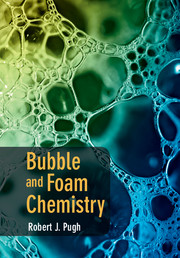Book contents
- Frontmatter
- Contents
- Preface
- Acknowledgments
- List of symbols
- 1 Basic principles and concepts
- 2 The nature and properties of foaming surfactants
- 3 Soap bubbles and thin films
- 4 Processes in foaming
- 5 Generation of bubbles and foams
- 6 Coalescence of bubbles in surfactant solutions
- 7 The stability/instability of bubbles and foams
- 8 Particle-stabilized foams
- 9 Foaming in non-aqueous liquids
- 10 Antifoaming and defoaming
- 11 Bubble size measurements and foam test methods
- 12 Bubble and foam chemistry - new areas of foam research
- Index
- References
10 - Antifoaming and defoaming
Published online by Cambridge University Press: 05 September 2016
- Frontmatter
- Contents
- Preface
- Acknowledgments
- List of symbols
- 1 Basic principles and concepts
- 2 The nature and properties of foaming surfactants
- 3 Soap bubbles and thin films
- 4 Processes in foaming
- 5 Generation of bubbles and foams
- 6 Coalescence of bubbles in surfactant solutions
- 7 The stability/instability of bubbles and foams
- 8 Particle-stabilized foams
- 9 Foaming in non-aqueous liquids
- 10 Antifoaming and defoaming
- 11 Bubble size measurements and foam test methods
- 12 Bubble and foam chemistry - new areas of foam research
- Index
- References
Summary
Fed officials used to think there was little they could do to prevent bubbles from inflating. Their strategy was to mop up after a bubble burst with lower interest rates.
Jon Hilsenrath, Wall Street Journal, 2 Dec, 2009.Background and types of antifoamers and defoamers
Although foams are thermodynamically unstable, under practical conditions they can remain fairly stable for a considerable period of time, and it is often necessary to add chemicals to prevent foaming or to destroy the foam. Early definitions of antifoamers referred to the chemicals or materials pre-dispersed in the liquid phase prior to processing to prevent foam formation (produce low foamability) while defoamers were added to eliminate existing stable foams (produce low foam stability) by a shock effect. However, today this distinction is confusing since most chemical additives cover several roles and the nomenclature varies according to the industry where they are used. In fact, they are often referred to as foam control agents, foam inhibitors, foam suppressants and air release agents.
Foaming causes problems throughout a range of industrial processes, for example, in the production and processing of paper, pharmaceuticals, materials, textiles, coatings, crude oil, washing, leather, paints, adhesives, lubrication, fuels, heat transfer fluids and so on. In the processing of food and beverages such as sugar beet, orange and tomato juice, beer, wine and mashed potatoes, foaming problems caused by soluble proteins and starch are commonly encountered. Food containers are washed and recycled and again foaming must be prevented during these processes. It is also frequently necessary to break foam in storage vessels to increase the capacity (such as beer), and foam breaking is necessary to increase the efficiency of distillation or evaporation processes. There are numerous reviews of the antifoaming/defoaming area and a comprehensive book by Garrett (1) in 1993 covers the basic physical chemistry and most of the industrial uses of antifoamers. A more recent publication by Garrett (2) in 2015 summarizes further developments associated with the mode of action and also the mechanical aspects of defoaming are reviewed. Early publications by Owen (3) classify different products, and Kerner (4) lists the antifoaming products supplied by major companies. There are over 100 suppliers, if smaller companies are included, and many international suppliers have manufacturing capacity whereas smaller companies specialize in formulations for particular industries or processes.
- Type
- Chapter
- Information
- Bubble and Foam Chemistry , pp. 331 - 371Publisher: Cambridge University PressPrint publication year: 2016



